An administrator wants to use the Call Queuemg feature on Cisco UCM to allow new customers to wait in the queue while other agents are not available to take their call. Which configuration step enables this feature?
An administrator is attempting to set up redundancy to allow users to make calls even if all Cisco UCM nodes go down or are unreachable by the IP phones.
Which feature must the administrator configure to accomplish this goal?
An engineer is configuring Cisco UCME to support SIP endpoints. The engineer wants to limit the system to 20 SIP phones and 50 directory numbers. Which code completes this configuration?
An engineer set up and successfully tested a TEHO solution on the Cisco UCM. PSTN calls are routed correctly using the IP WAN as close to the final PSTN destination as possible. However, suddenly, calls start using the backup local gateway instead. What is causing the issue?
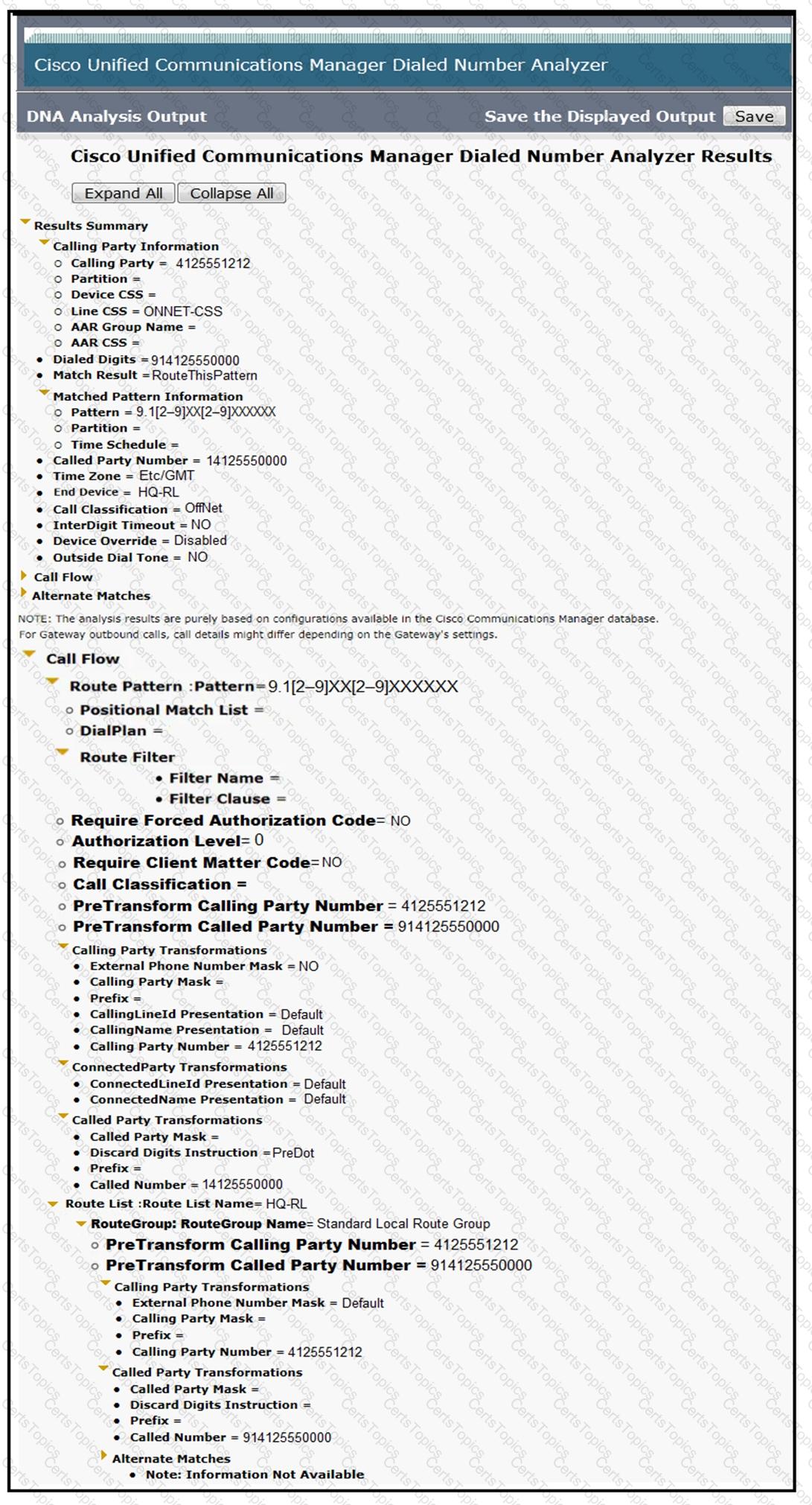
Refer to the exhibit. A collaboration engineer is troubleshooting an issue where the PSTN calls of a Cisco UCM IP phone user are not reaching the PSTN gateway. Which action resolves the issue?
In Cisco Unified Communications Manager globalized call routing is implemented and must confirm that it is correctly implemented without making a call. Which tool do you use for verification?

Refer to the exhibit. An administrator configured a new SIP trunk between Cisco UCM and Cisco Unified Border Element. Calls that use this new trunk are failing, and debugs from the Cisco Unified Border Element do not show any signaling received from Cisco UCM. The administrator verified that OPTIONS is enabled on the SIP profile configured on the trunk on Cisco UCM. The route pattern matched for this call is correctly configured to send calls to the Cisco Unified Border Element using this new trunk. What is the cause of this failure?
Which two descriptions of the Standard Local Route Group deployment are true? (Choose two.)
If all patterns below are configured in Cisco Unified Communications Manager which would be used when dialing the pattern “123”?
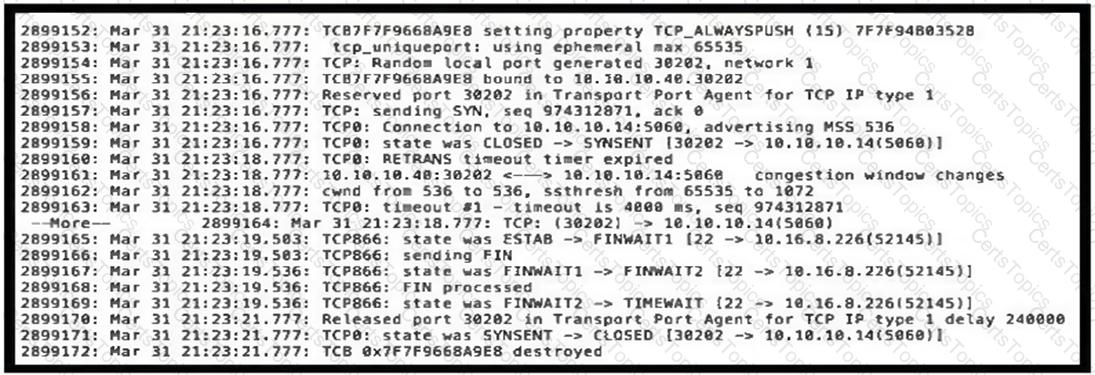
Refer to the exhibit. An engineer is trying to set up a new deployment using the SIP provider with TCP for signaling. After troubleshooting, the customer notices that the matching incoming dial peer and outgoing dial peer did not generate the INVITE to the SIP provider. Why is the call failing?
A customer routes PSTN calls to ITSP through a SIP trunk on Cisco UCM that forwards and receives calls to and from ITSP. ITSP is set to send an E.164 number when the customer's extension is four digits. Which action should be taken to route the incoming calls to four-digit extensions?
Refer to the exhibit.

The Cisco UCM is configured with four route patterns. When phone A dials 1515, which pattern does Cisco UCM choose as the correct match?
Users of a Cisco UCME report that calls lose audio after they are forwarded to some users. Calling point-to-point seems to function fine, but depending on the type of phone, some calls lose audio when forwarded. Looking at the trace header that shows:
Allow: INVITE,BYE,CANCEL,ACK,INFO,PRACK,COMET,OPTIONS,SUBSCRIBE,NOTIFY,REFER,REGISTER
What is missing and is a reason that the SRTP stream stops working?
How does an engineer globalize routing for ingress calls coming from the PSTN to internal DNs?
What is a capability of the gateway-preferred, network-based recording option in Cisco UCM?
CollabCorp is a global company with two clusters, emea.collab corp and apac.collab.corp. URI dialing is implemented and working in each cluster. The company configured routing between clusters to make inter-cluster calls via URI. but this is not working as expected. Which two configuration elements should be checked to resolve this issue? (Choose two.)
An administrator is working on an issue between the customer s Cisco Unified Border Element and the service provider. The provider only wants to see mid-call signaling from the Cisco Unified Border Element for fax calls. Which command must be configured on Cisco Unified Border Element?
When configuring hunt groups, where does the administrator add the individual directory numbers that should be part of the group?
Which two extended capabilities must be configured on dial peers for fast start-to-early media scenarios
(H.323 to SIP interworking)? (Choose two.)
An administrator has configured two route patterns, 9.911 and 9.[2-9]XXXXXX. When a user dials 9911. Cisco UCM waits for the T302 timer before routing the call. How will the administrator force interdigit timeout and route the call as soon as the user has finished dialing 9911, without waiting for the T302 timer to expire?
The sales department must answer phones when other sales members are not at their desks. The administrator knows that configuring Call Pickup allows the sales users to answer all the calls in the department by pressing only the softkey. Which call pickup configuration meets this requirement?
Which two configuration parameters are prerequisites to set Native Call Queuing on Cisco Unified Communications Manager? (Choose two.)
Refer to the exhibit.
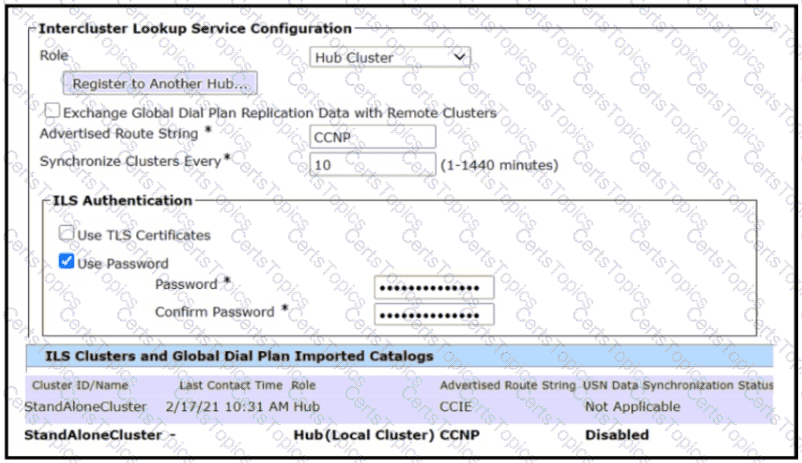
ILS has been configured between two hubs using this configuration. The hubs appear to register successfully, but ILS is not functioning as expected. Which configuration step is missing?
An administrator discovers that employees are making unauthorized long-distance and international calls from logged-off Extension Mobility phones when the authorized users are away from their desks Which two configurations should the administrator configure in the Cisco UCM to avoid this issue? (Choose two.)
For s SIP to SIP call flow, when does Cisco Unified Border Element require transcoding resources for DTMF?
The administrator of ABC company is troubleshooting a one-way audio issue for a call that uses H.323 protocol (slow-start mode). The administrator requests that you provide the IP and port information of the Real- Time Transport Protocol traffic that had the one-way audio call.
You gather the H.225 and H.245 messages for one of the one-way audio calls. Where can you find the RTP IP and port information for both sides? (Note: This call flow has not invoked any media resources like MTP or transcoders).
A company wants to use a Cisco phone system without the need for a local generic server. It is maximum 30 phones using a vendor-independent, industry-standard call protocol. What is the first command that must be entered to add this type of phone when registering a Cisco phone to this device?
In Cisco Unified Communications Manager, which tool do you use to check SIP traces?
An administrator is configuring a SIP trunk to an ITSP. The SIP connection will traverse from a Cisco UCM to the ISTP through a Cisco Unified Border Element. The ITSP has indicated that they require an in-band method for DTMF. Which command on the outbound dial-peer to the ITSP will meet this requirement?
Phone A calls to phone B, but phone B has Call Forward All set to a PSTN number. The route list responsible for the phone B call to the PSTN has a standard local route group configured. Which route group must be used to send the call to the PSTN?
An engineer must configure a Cisco UCM hunt list so that calls to users in a line group are routed to the first idle user and then the next. Which distribution algorithm must be configured to accomplish this task?
An engineer is troubleshooting local ringback on a Cisco SIP gateway The gateway is not ignoring the SIP 180 response with SDP from the service provider, and the far end device is sending the 180 with SDP to play ringback from the IP address specified m the SDP Which configuration change must be made on the gateway to resolve the issue?
Which elements does Cisco cloud mobility for collaboration include?
A company is using Cisco Jabber on-premises to make B2B calls on video. The calls are using Cisco Expressway-C and Expressway-E and have been configured in Cisco UCM to be able to call any URI on the internet. The Jabber client also has voice enabled and must be able to call local, regional, and international numbers. Where must Cisco UCM be configured to meet this requirement for URI dialing?
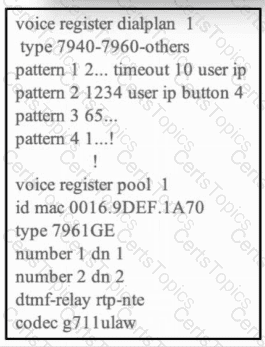
Refer to the exhibit. An engineer is implementing the Cisco UCME and must set up a dial plan for the 7961 SIP phones to recognize digit strings dialed by users.
Which code snippet completes the configuration?
Which two statements are correct with respect to the Client Matter Code setting in the route pattern configuration? (Choose two.)
A collaboration engineer is configuring call pickup for a Cisco UCM user that currently has a working BLF speed dial button for the teammate's extension. The user wants to see calls ringing on the teammate's extension and to answer those calls by pressing the BLF speed dial button. Which configuration step meets this requirement?
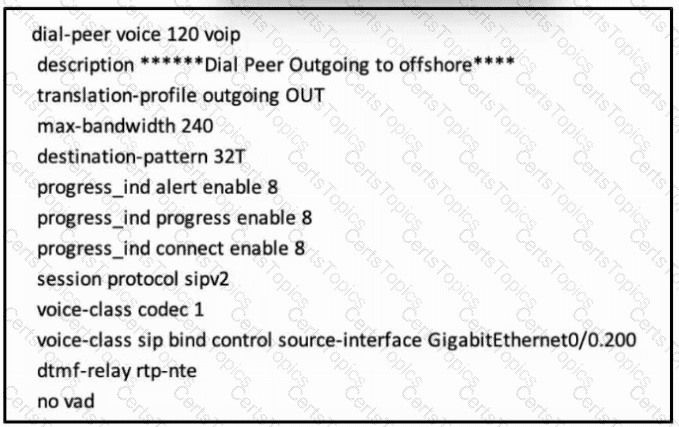
Refer to the exhibit. An engineer configured Call Admission Control on Cisco Unified Border Element to reject SIP calls when the aggregate bandwidth that is required for the calls exceeds the threshold. However, users complain of dropped calls when they place calls on hold during peak periods.
Which solution resolves this challenge?
Why would RTP traffic that is sent from the originating endpoint fail to be received on the far endpoint?
Which two types of authentication are supported for the configuration of Intercluster Lookup Service? (Choose two.)
Configure Call Queuing in Cisco Unified Communications Manager. Where do you set the maximum number of callers in the queue?
The Cisco Unified Communications Manager Dialed Number Analyzer allows analysis of calls from which two devices? (Choose two.)
An IP Telephony administrator is deploying IP phones The administrator has an existing Cisco UCME router with several SCCP & SIP phones registered. The administrator receives a request for a new SIP phone with MAC address 1111 2222.3333 and directory number 2050 to be added in the Cisco UCME. Which two configurations should be added in CME to support this request? (Choose two )
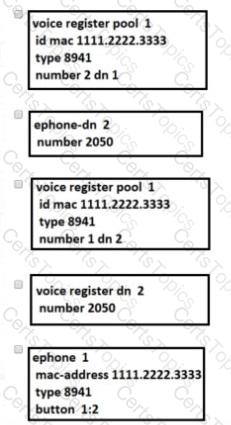
An administrator is trying to apply configuration changes on Cisco CME. When the users registered on Cisco CME to dial a local number to a PSTN call, the Cisco CME sends an incorrect number of digits. What translation rule fixes the issue and sends the correct number of digits?
An engineer has two cisco UCM Clusters and wants to integrate them using ILS with TLS certificates. Cluster A (pub and 1 subscriber) will be the hub, and Cluster B (pub and 1 subscriber) will be the spoke. Both Clusters have self-signed certificates. The engineer has exchanged Publisher A and subscriber B Tomcat certificates, but the connection fails. What is the cause of the failure?
Refer to the exhibit.
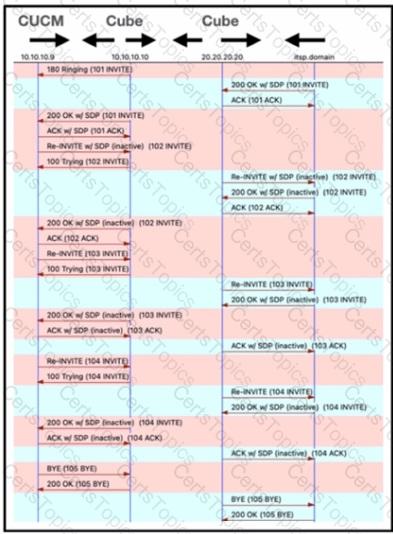
A no-way audio situation was experienced after the calling party on an outbound call placed the call on hold and then resumed from hold. Which action will resolve the issue?
Some users report poor quality when they travel to another continent and make calls. This issue applies only to one continent and not to others, where typically the dialing is fast and quality is clear. Users experience the same result at home when they call the same numbers in that specific continent. It seems like some users do not exist in the correct PSTN gateway when making calls to a specific country. The company is using TEHO to save on the cost of international or long-distance calling.
They are also using a globalized dial plan. What is the cause of the issue?
Which configuration must an administrator perform to display Translation Pattern operations in Cisco Unified Communications Manager SDL traces?
Refer to the exhibit.

Users report high delays when calling national numbers in the United States. An engineer analyzes the route patterns in Cisco UCM. What must be done to resolve this issue?
An engineer is configuring a Cisco Collaboration system for SIP endpoints and must enable Survivable Remote Site Telephony for these endpoints. Which code completes this configuration on the SRST gateway?
A)

B)

C)
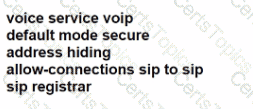
D)

A user in location X dials an extension at location Y. The call travels through a QoS-enabled WAN network, but the user experiences choppy or clipped audio. What is the cause of this issue?
An administrator must control the number of calls to a remote specific site to reduce bandwidth constraints. The users on that remote site report bad quality of the calls passing through that WAN link. Which action must the administrator take in Cisco UCM to resolve the issue?
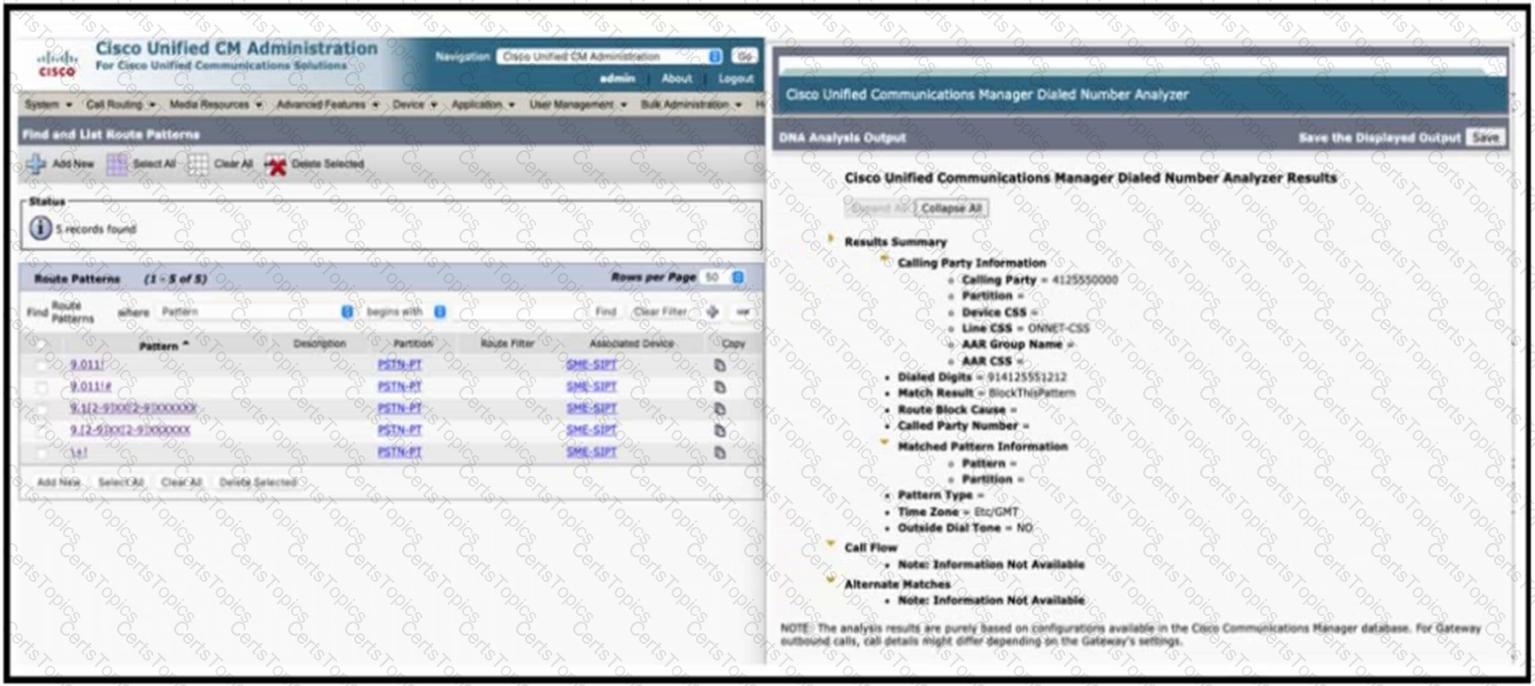
Refer to the exhibit. A collaboration engineer is troubleshooting an issue where a user of a Cisco UCM IP phone reports failed calls when trying to dial out to the PSTN. Which action resolves the issue?
An engineer is configuring a call park feature in Cisco Unified Communications Manager Express. Which command does the engineer use to ensure that the call is reverted to the user after 60 seconds?
What does VoIP trace in a Cisco Unified Border Element do?
An organization needs to ensure that the Cisco UCM can provide a resume softkey to users on their desk phones when they disconnect an anchored call on their mobile phone. Which solution must be used to accomplish these goals?
Cisco SIP IP telephony is implemented on two floors of your company. Afterward, users report intermittent voice issues in calls established between floors. All calls are established, and sometimes they work well, but sometimes there is one-way audio or no audio. You determine that there is a firewall between the floors, and the administrator reports that it is allowing SIP signaling and UDP ports from 20000 to 22000 bidirectionally. What are two possible solutions? (Choose two.)
Which description of RTP timestamps or sequence numbers is true?
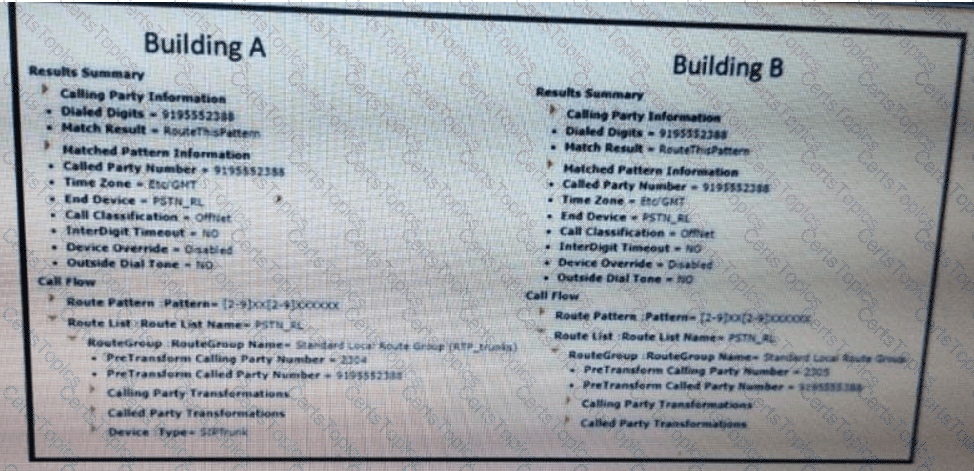
Refer to the exhibit. A standard local route group is configured for long-distance calls. Calls from building A succeed, but calls from building B fail. On the system. Each building has is own device pool. The DNA tool is used to test the configuration. How is this issue resolved?
A company is using third-party phones on the internal network at a location behind a Cisco Unified Border Element. These phones seem to work with only two types of codecs, which are high-complexity codecs.
Which configuration ensures that calls are completed with the correct and working media each time?
What is a function of the metadata carried in SIP sessions between the recording client and the recording server?
An administrator is troubleshooting call failures on an H.323 gateway via the CLI. To see signaling for media and call setup, which debug must the Administrator turn on?
A user’s phone is already configured for Single Number Reach, and the user wants a feature to move an active call from a mobile phone to a desk phone and vice-versa. As an administrator, which additional configuration should be made to fulfill the user’s request?
When an administrator troubleshoots H.323 call setup, which message gives an alert that the called party is being notified about the call?
Refer to the exhibit.
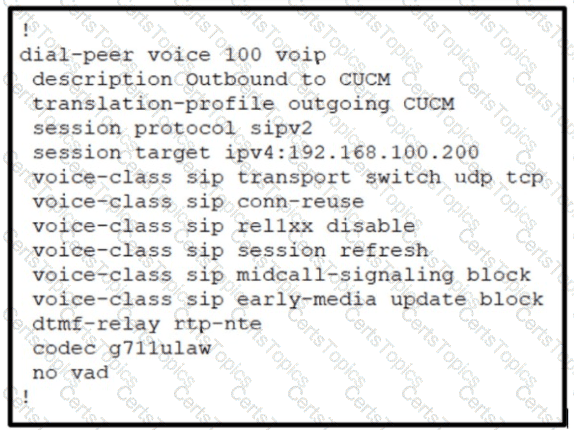
An engineer is troubleshooting an issue where inbound calls to Cisco UCM with early media fail to establish. While investigating the issue, the engineer finds that Cisco UCM is set to require a PRACK. but the Cisco Unified Border Element is not sending it. Which command is causing this issue?
An administrator is asked to configure egress call routing by applying globalization and localization on Cisco UCM. How should this be accomplished?
A Collaboration engineer wants to deploy Global Dial Plan Replication for advertising its global dial plan data, including the global dial plan data that was configured locally and any data that was learned from other clusters. The engineer is configuring the inter-cluster lookup service on the Cisco UCM and activated the ILS service and configured the cluster IDs.
What is the next step in the configuration?
Which set of commands binds SIP media and signaling to interface GigabitEthernet0/0 when dial peer 1 is chosen for call routing?
Refer to the exhibit.
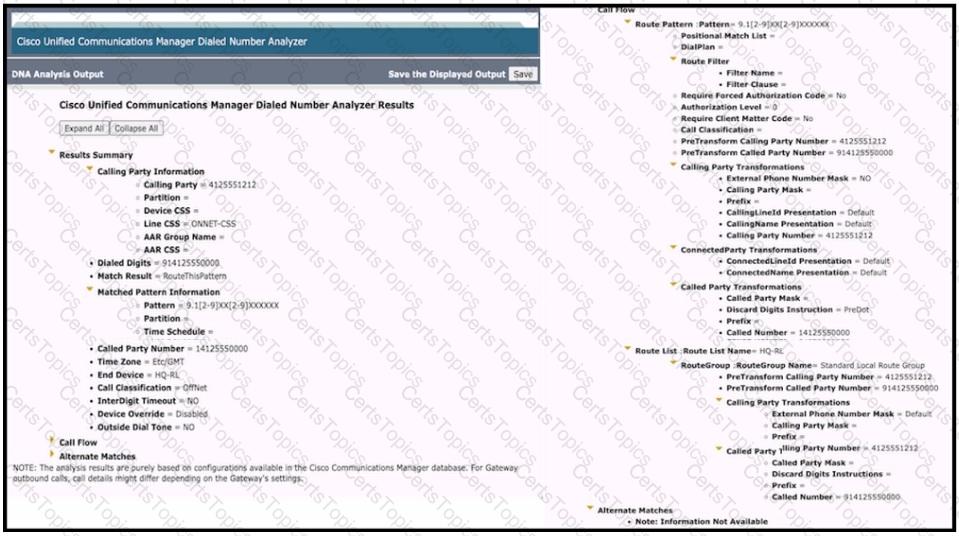
A collaboration engineer is troubleshooting an issue where the PSTN calls of a Cisco UCM IP phone user are not reaching the PSTN gateway. Which action resolves the issue?
An engineer needs to deploy Cisco Extension Mobility. The engineer already activated the required services, configured the Extension Mobility Phone Service, and created an Extension Mobility device profile that is associated with end users. Which two additional steps are required to complete the configuration? (Choose two.)
Refer to the exhibit.

Which INVITE is sent to 10.10.100.123 as a result of this log?
A)

B)

C)

D)
